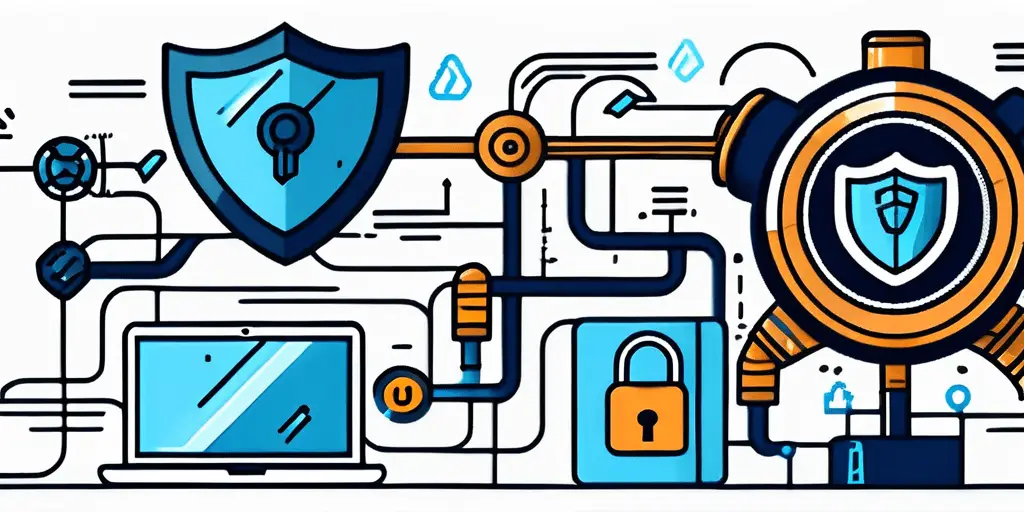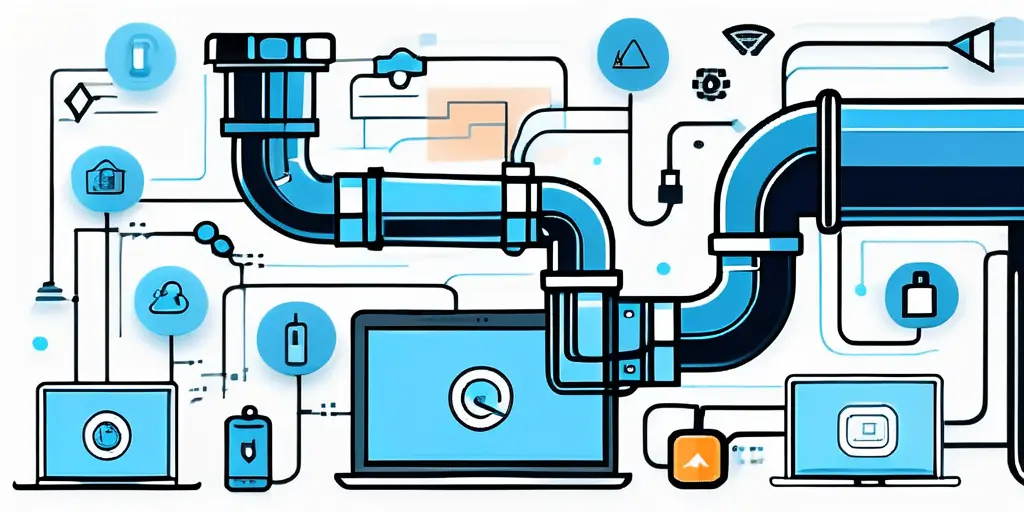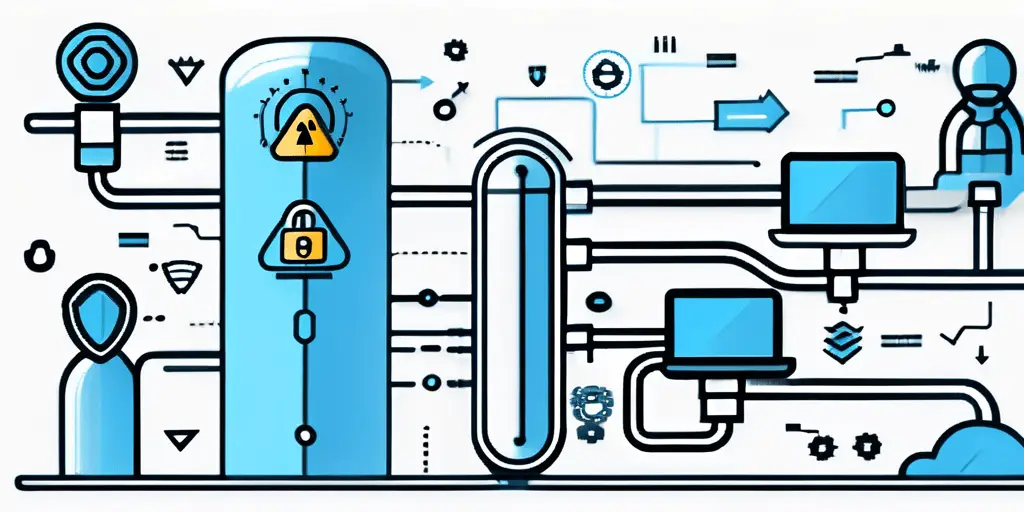A software pipeline is a series of interconnected steps that software goes through during its development and deployment process. Each step in the pipeline serves a specific purpose, such as code compilation, testing, and deployment. This article explores the concept of a software pipeline and examines the crucial role of security within it.
Understanding the Concept of a Software Pipeline
Software development has evolved over the years, and the traditional methods of developing and delivering software have become outdated and inefficient. A software pipeline, also known as a software delivery pipeline or deployment pipeline, is an approach that streamlines the software development process by breaking it down into smaller, manageable tasks.
By breaking the development process into smaller stages, software pipelines enable teams to work collaboratively and deliver software more rapidly. This iterative approach allows for continuous integration, testing, and deployment, ensuring that the software is of high quality and meets the changing needs of users.
However, understanding the basics of a software pipeline is just the beginning. Let’s dive deeper into the various stages and key components that make up a software pipeline.
The Basics of a Software Pipeline
At its core, a software pipeline consists of multiple stages or phases. Each phase has its own purpose and tasks, contributing to the overall development and delivery of the software. These phases typically include code compilation, testing, integration, and deployment. For example, a basic software pipeline may consist of the following stages:
- Code Compilation: This stage involves converting the source code into executable code that can be run on the target platform.
- Unit Testing: In this stage, individual units of code are tested to ensure they function correctly in isolation.
- Integration Testing: Here, the different units of code are combined and tested together to ensure they work seamlessly.
- Deployment: The final stage involves deploying the software to the production environment, making it available for end-users.
These stages ensure that the software is thoroughly tested and validated before being deployed to production environments. It’s important to note that these stages can be customized and expanded based on the specific needs of the software development project.
Key Components of a Software Pipeline
While the specific components of a software pipeline can vary depending on the organization and software development practices, there are some common components that are typically present:
- Source Code Repository: A central repository where developers store and manage their code. This allows for version control, collaboration, and easy access to the codebase.
- Build System: The system responsible for compiling and building the software. It takes the source code and transforms it into an executable form.
- Automated Testing Framework: A framework that automates the testing process, ensuring the software meets the desired quality standards. It includes unit tests, integration tests, and other types of tests that verify the functionality and performance of the software.
- Deployment Automation: Tools and processes used to automate the deployment of the software to various environments. This ensures consistency and reduces the risk of human error during the deployment process.
- Monitoring and Feedback Loop: Systems that provide insights into the performance and behavior of the software in production environments. This allows for monitoring, logging, and gathering feedback from users, enabling continuous improvement and bug fixing.
These components work together to ensure smooth and efficient software development, testing, and deployment. They provide the necessary infrastructure and tools to support the software pipeline and enable teams to deliver high-quality software in a timely manner.
As software development continues to evolve, the concept of a software pipeline will remain a fundamental aspect of modern software engineering. By embracing this approach, organizations can enhance their development processes, improve collaboration, and deliver software that meets the ever-changing needs of users.
The Role of Security in a Software Pipeline
Software security is a critical aspect that should be integrated into every stage of the software pipeline. The increasing number of cyber threats and the potential impact of security breaches have made it essential to prioritize security throughout the software development lifecycle.

Importance of Security in Software Development
Ensuring the security of software is paramount, as vulnerabilities in software can have severe consequences, including data breaches, financial losses, and damage to a company’s reputation. Integrating security measures from the early stages of development reduces the risk of vulnerabilities and strengthens the overall security posture of the software.
Real-world examples highlight the importance of prioritizing security in software development. In 2017, Equifax, one of the largest credit reporting agencies, experienced a massive data breach that exposed sensitive information of millions of people. The breach was attributed to a vulnerability in their software, emphasizing the need for robust security practices.
Integrating Security Measures into the Pipeline
To ensure the security of software, organizations need to adopt a proactive approach by integrating security measures into their software pipelines. This involves implementing security practices throughout the development process, including:
- Security Code Reviews: Regular reviews of the code to identify and address security vulnerabilities.
- Security Testing: Conducting comprehensive security testing, including static application security testing (SAST) and dynamic application security testing (DAST).
- Secure Configuration Management: Ensuring that all components of the software pipeline are properly configured and hardened against potential threats.
- Automated Security Scanning: Using automated tools to continuously scan the software and detect vulnerabilities.
By integrating security measures into the software pipeline, organizations can effectively mitigate security risks and protect their software and data.
Moreover, it is crucial to establish a security-focused culture within the development team. This means fostering an environment where security is seen as a shared responsibility and not just the concern of a dedicated security team. Developers should be trained in secure coding practices and encouraged to prioritize security in their day-to-day work.
Additionally, organizations should stay updated with the latest security threats and vulnerabilities. This can be achieved by actively participating in security communities, attending conferences, and conducting regular security awareness programs for the development team. By staying informed, organizations can proactively address emerging security challenges and adapt their security measures accordingly.
Furthermore, it is essential to conduct regular security audits and assessments to identify any weaknesses in the software pipeline. These audits can help uncover potential vulnerabilities and provide valuable insights into areas that require improvement. By conducting these assessments, organizations can continuously enhance their security practices and ensure that their software remains resilient against evolving threats.
Different Types of Security Measures in a Software Pipeline
There are various security measures that organizations can implement throughout the software pipeline to strengthen the security of their software:

Static Application Security Testing (SAST)
SAST involves analyzing the source code or compiled code of an application for potential security vulnerabilities. SAST tools scan the code to detect common coding errors and vulnerabilities, such as input validation issues, insecure data storage, and insecure cryptographic practices. By identifying these vulnerabilities early in the development process, developers can take appropriate measures to address them.
One of the key advantages of SAST is its ability to uncover security issues in the codebase before the application is deployed. This proactive approach helps in reducing the overall security risks associated with the software. Additionally, SAST tools can be integrated into the development environment, providing real-time feedback to developers and enabling them to write more secure code from the outset.
Dynamic Application Security Testing (DAST)
DAST involves testing the application during runtime to identify vulnerabilities that may not be apparent from a static analysis of the code. DAST tools simulate attacks on the application and identify potential weaknesses in user input validation, authentication mechanisms, and access controls. By conducting dynamic testing, organizations can assess the security of their applications in real-world scenarios.
Unlike SAST, which focuses on the code itself, DAST evaluates the application from the outside, mimicking how a potential attacker would interact with it. This approach provides valuable insights into the security posture of the application in a production environment. DAST can uncover vulnerabilities that may only manifest when the application is running and processing user input, making it a crucial component of a comprehensive security testing strategy.
Challenges in Implementing Security in a Software Pipeline
While integrating security into a software pipeline is essential, organizations often face challenges in implementing effective security measures. These challenges can arise due to the inherent complexities of software development and deployment. As software pipelines become more complex, ensuring consistent security measures across all stages becomes increasingly challenging. It requires organizations to navigate through a maze of intricacies to safeguard their software assets.

One of the primary challenges organizations encounter is dealing with resource constraints and a lack of expertise in implementing security practices effectively. In an ever-evolving threat landscape, staying up-to-date with the latest security measures can be a daunting task. Organizations may find themselves grappling with limited resources and struggling to find skilled professionals who possess the necessary knowledge and experience to tackle security challenges head-on.
Real-world statistics further highlight the prevalence of security issues in software pipelines. According to the 2020 Verizon Data Breach Investigations Report, a staggering 43% of data breaches involved web applications. This alarming statistic underscores the urgent need for improved security practices throughout the software development process.
Overcoming Security Implementation Challenges
Overcoming security implementation challenges requires a comprehensive approach that addresses both technical and cultural aspects. Organizations need to adopt a multi-faceted strategy to fortify their software pipelines against potential threats.
Education and training play a pivotal role in equipping developers and other stakeholders with the necessary knowledge and skills to navigate the complex world of secure coding practices. By providing comprehensive training programs, organizations can raise awareness about the importance of security and empower their teams to make informed decisions that prioritize security.
Leveraging automation tools and frameworks is another crucial aspect of overcoming security challenges. Automation can help ensure consistent security measures throughout the software pipeline, reducing the risk of human error and enhancing overall efficiency. By automating security checks and tests, organizations can identify vulnerabilities early on and address them proactively.
Collaboration between development, security, and operations teams is vital in fostering a shared responsibility for security. By breaking down silos and encouraging cross-functional collaboration, organizations can create a unified front against potential threats. This collaborative approach allows for a more holistic view of security, enabling teams to identify and mitigate risks collectively.
Furthermore, cultivating a culture of security is paramount. Organizations must make security a top priority and embed security practices into the organizational culture. By fostering a security-conscious mindset among employees, organizations can create an environment where security is not an afterthought but an integral part of every decision and action.
By addressing these challenges head-on, organizations can effectively implement security measures and protect their software assets from the ever-present threats in today’s digital landscape. It is an ongoing journey that requires constant vigilance and adaptation to stay one step ahead of potential adversaries.
Future Trends in Software Pipeline Security
The field of software pipeline security continues to evolve as organizations strive to stay ahead of emerging threats and vulnerabilities. Several trends are shaping the future of software pipeline security:
Advancements in Software Security Measures
The advancement of technology has brought about innovative security measures that go beyond traditional approaches. For example, the use of machine learning and artificial intelligence techniques can enhance the ability to detect and prevent security incidents. By leveraging intelligent security solutions, organizations can proactively identify and respond to potential threats.
One of the key advancements in software security measures is the integration of behavioral analytics. This approach involves analyzing user behavior patterns to identify anomalies and potential security breaches. By understanding normal user behavior, organizations can detect suspicious activities and take appropriate actions to mitigate risks.
The Future of Secure Software Pipelines
The future of secure software pipelines lies in the integration of security practices into the development process from the very beginning. This involves incorporating security requirements into the design phase, conducting continuous security testing, and implementing automated security checks throughout the pipeline. By building security into the software development lifecycle, organizations can ensure the delivery of secure and resilient software.
Another aspect of the future of secure software pipelines is the adoption of DevSecOps practices. DevSecOps combines development, security, and operations teams to collaborate and integrate security into every stage of the software pipeline. This approach promotes a culture of shared responsibility and enables organizations to address security issues early on, reducing the risk of vulnerabilities.
In conclusion, software pipelines play a crucial role in modern software development, enabling organizations to deliver high-quality software efficiently. However, security must be a paramount consideration throughout the software pipeline to protect against potential vulnerabilities and cyber threats. By implementing and continuously improving security measures, organizations can safeguard their software assets and maintain trust with their users.
As the landscape of software pipeline security continues to evolve, organizations must stay vigilant and adapt to emerging trends. By embracing advancements in software security measures and integrating security practices into the development process, organizations can stay one step ahead of cyber threats and ensure the delivery of secure software. The future of software pipeline security holds great promise, and it is up to organizations to seize the opportunities and protect their valuable assets.
As you navigate the complexities of software pipelines and the critical role of security within them, remember that the right expertise can make all the difference. Blue Goat Cyber, with its specialized focus on B2B cybersecurity services, stands ready to secure your medical devices, ensure compliance with HIPAA and FDA regulations, and provide comprehensive penetration testing. As a Veteran-Owned business, we’re committed to protecting your operations from cyber threats with diligence and precision. Contact us today for cybersecurity help and partner with a team that’s as dedicated to your security as you are to your users.


